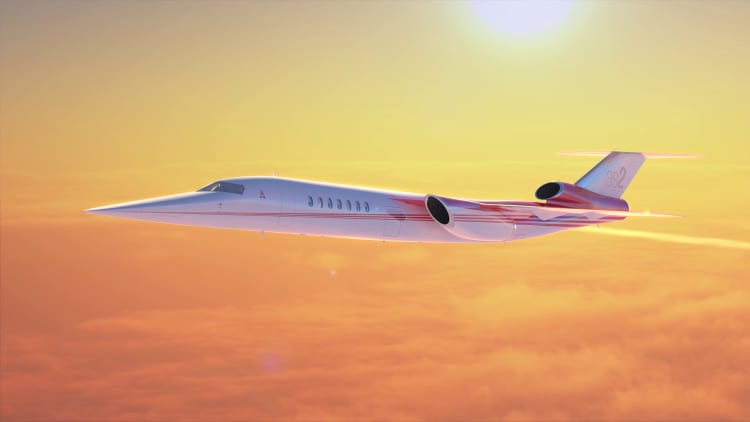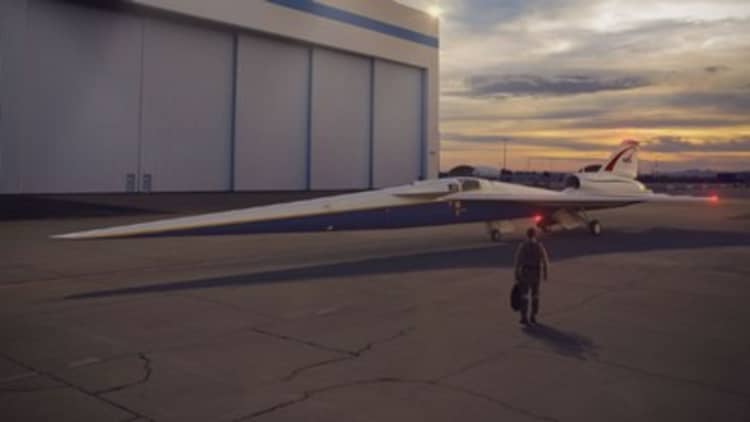
WASHINGTON — Boeing is partnering with supersonic start-up Aerion to develop a jet that will bring back the luxury of faster-than-sound business travel, the aerospace giant announced Tuesday.
The AS2 aircraft, designed to fly at Mach 1.4 or approximately 1,000 miles per hour, is slated for its first flight in 2023. Along with the partnership, Boeing said it "made a significant investment in Aerion" although the companies did not disclose financial terms of the agreement. That investment will help Aerion "accelerate technology development and aircraft design," Boeing said.
"Through this partnership that combines Aerion's supersonic expertise with Boeing's global industrial scale and commercial aviation experience, we have the right team to build the future of sustainable supersonic flight," Steve Nordlund, vice president and general manager of Boeing NeXt said in a statement.
GE Aviation is supplying its Affinity supersonic series of jet engines for AS2. Lockheed Martin and Airbus previously worked on AS2.
Boeing unveiled a rendering for a hypersonic passenger plane in June, which is the next speed class above supersonic. Boeing's design was for a plane that could fly as fast as Mach 5, or about 3,900 miles per hour. Along with Aerion's AS2, these plans are looking to bring back the luxuries of traveling on board the supersonic Concorde, which was retired 15 years ago. Several startups are racing to get next-generation supersonic prototypes in the air. But each must overcome the deficiencies of the Concorde, which was costly and limited in commercial use.

Lockheed Martin also working on a supersonic jet
Last year, NASA awarded Lockheed Martin a contract worth nearly $250 million to develop an aircraft capable of reaching supersonic speed without creating the deafening sonic boom that comes with breaking the sound barrier. In November, the defense giant announced its experimental supersonic plane had entered production.
Lockheed's X-59 Quiet Supersonic Technology aircraft, which is designed to cruise at 55,000 feet and reach speeds of about 940 miles per hour, is expected to create a noise level akin to the sound of a car door closing.
Current regulations ban commercial supersonic aircraft from operating over land. New companies like Boom Supersonic are trying to make use of the technology for transoceanic routes, with backing from investors like Richard Branson and Japan Airlines.
Read more: Lawmakers pave the way for the return of supersonic flight
But Lockheed Martin and NASA want to advance the technology through noise reduction to overturn regulations. The new experimental plane is designed to return supersonic air travel to routes over land. The last such flight was by the Concorde in October 2003.

The X-59 will conduct its first flight in 2021. It will be used to collect community response data on the acceptability of the quiet sonic boom generated by the aircraft, helping NASA establish an acceptable commercial supersonic noise standard to overturn current regulations banning supersonic travel over land.
Lockheed Martin is also in the process of developing the SR-72, a hypersonic unmanned plane dubbed the "son of the Blackbird." And when it comes to developing a high-speed reconnaissance aircraft, the Pentagon's top weapons supplier is playing in its home court.
In 1976, the Air Force flew Lockheed Martin's SR-71 Blackbird from New York to London in less than two hours — at speeds exceeding Mach 3, or three times the speed of sound.
The SR-72 is envisioned to operate at speeds up to Mach 6. And while the hypersonic SR-72 isn't expected to be operational until 2030, the company sees developing a platform of that magnitude as a game changer.
"This could forever change our ability to deter and respond to conflict, allowing warfighters to quickly address threats before an adversary may have time to react," Lockheed Martin CEO Marillyn Hewson said of the hypersonic plane in March.
Hewson also said the development of the aircraft, which is estimated to cost $1 billion, will change the "definition of air power by giving the U.S. significant tactical and strategic advantages."



